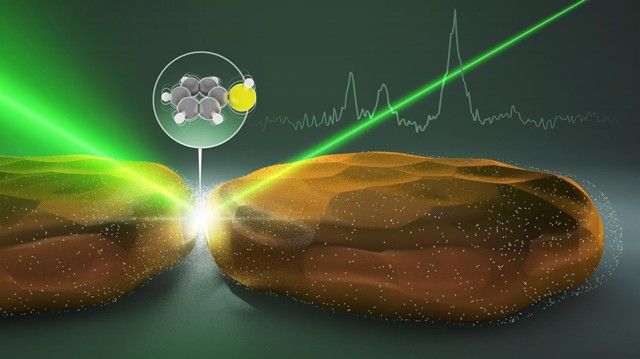 Light mediated detection of a molecule. © N. Antille/EPFL
Light mediated detection of a molecule. © N. Antille/EPFL
A new method of increasing the signal of Surface-Enhanced Raman Scattering (SERS) has been developed which means single molecules can be identified and studied. SERS is an enhanced form of Raman Spectroscopy, a technique which uses infra-red lasers to determine the molecular constituents of a sample without causing any permanent changes.
SERS is a highly sensitive technique that facilitates the detection of vibrations within the atoms of a single molecule irrated with infrared light. These vibrations are observed as a change in he radiations frequency. However, the sensitivity of this technique is limited at room temperature as molecular vibrations are weak at low temperatures.
Researchers at EPFL, led by Philippe Roelli, have demonstrated that this limitation in SERS can be overcome by using cavity optomechanic, which are based on the interaction between mechanical objects and light.
Raman spectroscopy and weak vibrations
SERS is an advanced form of Raman spectroscopy; an established technique that is used to analyze molecules based on the way laser light influences their vibrations. Molecular vibrations cause elongations and compressions of chemical bonds, which are associated with the absorption of radiation. This absorption is observed as a shift in the lasers frequency. The shift in frequency is specific to certain molecules and functional groups which facilitates their identification.
However, the analysis of single molecules cannot be effectively done using Raman spectroscopy as the Raman interaction that occurs between molecules and radiation is very weak, with less than 1% of the laser light interacting with molecules in this way.
This is because a single molecule has a size a thousand times smaller than the wavelength of the radiation used to analyse them meaning the interaction is weak. SERS overcomes this limitation by surrounding the molecule with a cloud of oscilating electrons which are provide by laser-excited metallic nanoparticles. These clouds of electrons, known as plasmons, can be localized to nanometer-size gaps in which molecules could be placed.
The metallic nanoparticles behave as nano-antennas that chanel the radiation towards the molecule. The sensitivity of SERS is enhanced by a factor of 10 using this technique. Although the fist limitation was addressed, the second limitation was not addressed.
However, whilst this solves the problem of weak interactions between the molecule to be studied and the laser this does not resolve the fact that molecules only weakly vibrate o at room temperature. This is desribed in technical terminology as the vibrational modes being frozen, i.e. unresponsive to radiaiton.
Amplifying molecular vibrations with light
A theoretical solution was proposed by the team at EPFL, which showed that the sensitivity and resolution of SERS could be extended further. The plasmon cloud of oscillating electrons was used to exert force on the vibrations of the molecules being studied.
The exact conditions under which the radiation induced force drives the molecular vibrations to large amplitudes was determined, with specific wavelengths chosen according to other research conducted on plasmon behaviour.
Getting more signal out of a molecule
The radiation-force increases the vibrations of the molecule, which in turn strengthens the interactions between the molecule and the laser light. As these interactions strengthen, the signal created by SERS also increases to levels that were not possible with mechanisms followed earlier.
Our work offers specific guidelines for designing more efficient metallic nanostructures and excitation schemes for SERS. It can push the limits of the technique in sensitivity and resolution.
Philippe Roelli - EPFL
The research opens new research directions in the control of molecular vibrations with light, with potential applications ranging from biology and chemistry to quantum technologies.
The report has been published in Nature Nanotechnology